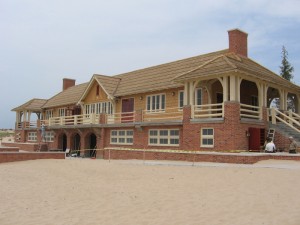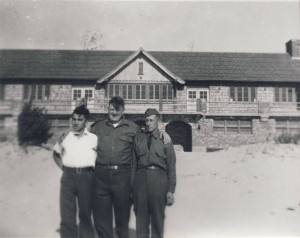When the state of Michigan was given 3,500 acres of logged-over land on the shores of Lake Michigan in 1926, it was hoped that the nearby Big Sable Point Lighthouse might become a beacon not only for ships but for tourists as well. Back then, the land was reachable only by foot or boat, and the state lacked money to develop it as a park. That changed in 1933 with the advent of the New Deal.
The Pere-Marquette S-2 CCC Camp quickly went up on the state’s land and the young men of the Michigan Civilian Conservation Corps began shaping the sand dunes, beaches, and skid trails into the Ludington State Park.
Under the direction of the National Park Service, they built roads, retaining walls, campgrounds, hiking trails, the park’s headquarters, and the Lake Michigan Beach House. Designed by renowned NPS architect Ralph B. Herrick, the one-of-a-kind, arts-and-crafts-style Beach House is regarded as the crown jewel of Michigan’s park system.
The CCC Boys hand dug the foundation, water system, and septic field for the 116-foot building. A deal struck with the Morton Salt Company in the nearby town of Ludington had the CCC tear down a derelict salt mill in exchange for salvaged materials. The Corps carefully reclaimed the rust- colored bricks and massive, rough-sawn, white pine beams to build the two-story Beach House.
Time and weather took their toll on the 1935 landmark. In 1999 the state undertook a $1.6 million restoration of the iconic building. Reconstruction began in 2012. The interior was gutted and a new wood shingle roof was installed. The exterior— sandblasted over decades by the fierce Lake Michigan winds—was refurbished with new bricks and mortar carefully chosen to match the original.
The upper floor, which had been subdivided, was restored to one large room. The original stone fireplace still occupies the south end. Doors on three sides lead to a veranda and patio. In place of the original changing rooms, there’s now a café and gift shop. New signage along the beach walk interprets the geology of Lake Michigan and some of the largest freshwater sand dunes in the world.
Ludington State Park has grown to 5,300 acres and receives nearly a million visitors annually. The Lake Michigan Beach House was added to the National Register of Historic Places this year. A display honoring the men of the CCC who built the state park soon will be installed in the beautiful Beach House they constructed.
With thanks to Alan Wernette, State Park Interpreter,
Ludington State Park



